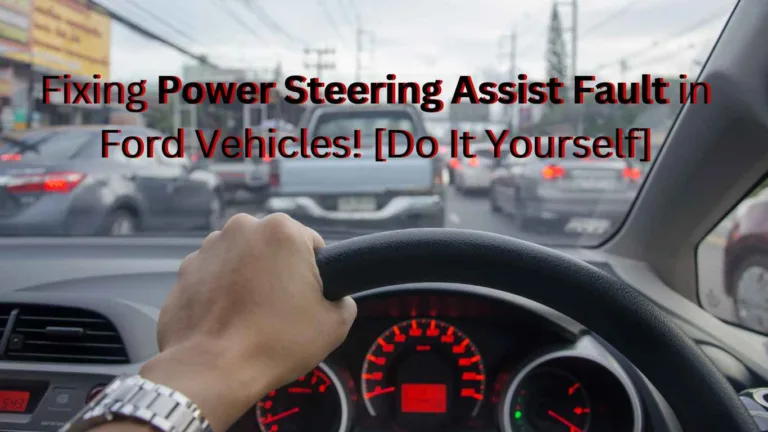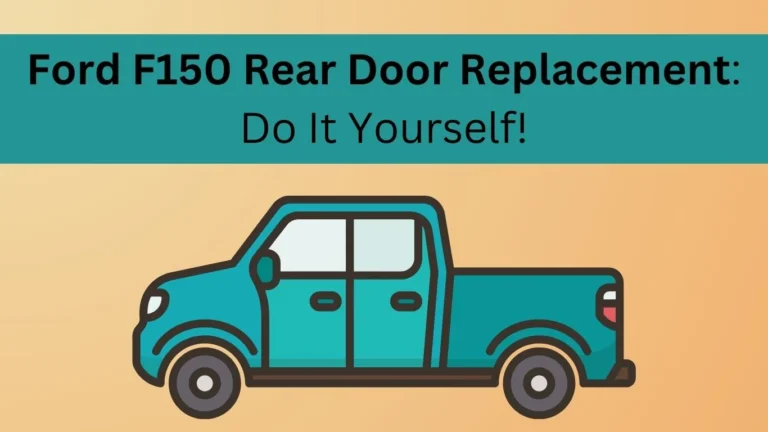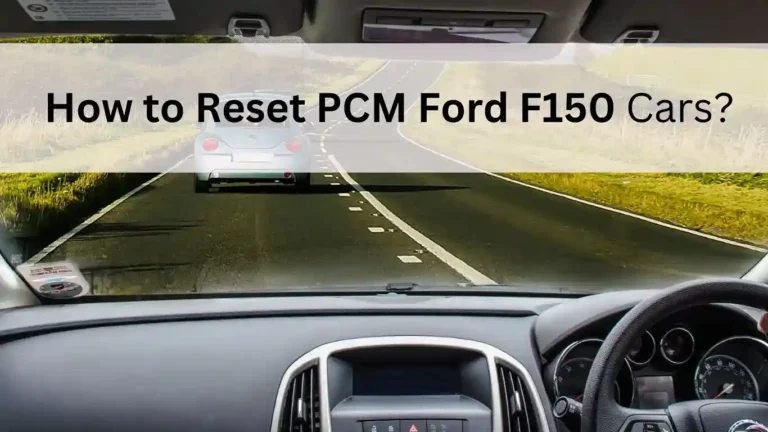Ford drivers may face power steering assist fault, caused by broken parts, system glitches, or blown fuses. Fixing it involves replacing damaged parts, resetting the system, or installing new fuses.
Don’t worry if you don’t know much about it or find this tricky. In this guide, I’ll break down everything – from understanding power steering to recognizing signs of trouble, deciphering error codes, identifying causes, and how to fix them.
Let’s dive in!
Table of Contents
What Is Power Steering Assist and How Does It Work?
The power steering assist mode works via the Electric Power Steering (EPS). It is made up of different parts like speed sensors, torque sensors, controllers, a power driver circuit, memory, a clutch, and a DC motor.
The controller is like the brain of the system. It uses signals from the sensors to figure out how fast the wheels are turning and how much force is on the steering wheel.
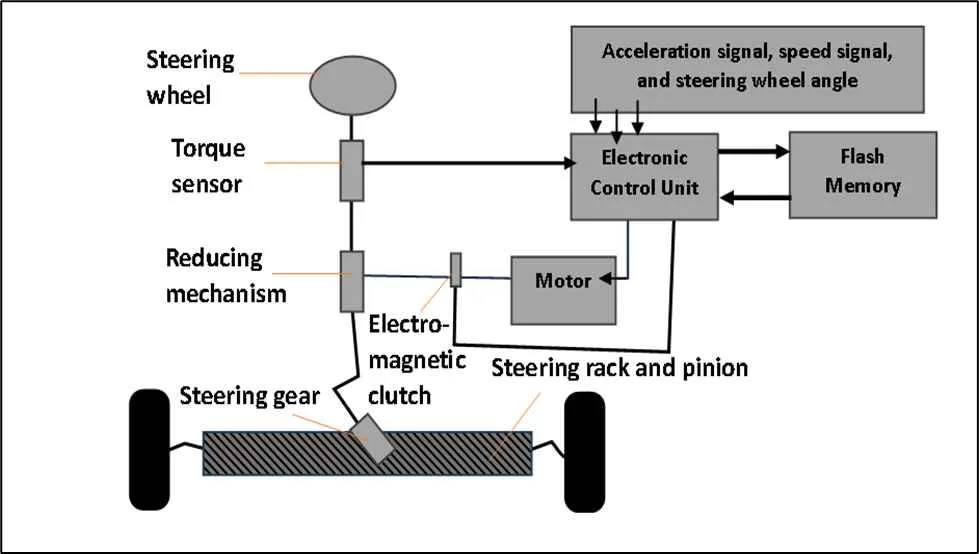
Based on the Matec Conferences, it tells the motor which way to turn and how much power to give. It also controls how the motor moves by using the power driver circuit.
The motor’s movement is then used to help you steer. It works with gears and other parts to make your steering easier by increasing the force while slowing down the motor’s speed. This makes it easier for you to turn the steering wheel.
Thanks to a smart program, the motor’s force can be changed as needed. This helps the whole system adjust to give you the right amount of steering assistance.
Symptoms of Power Steering Assist Fault in Ford!
There are a few signs that indicate that your Ford car has some issues with the power steering. In case you don’t know, here’s the details:
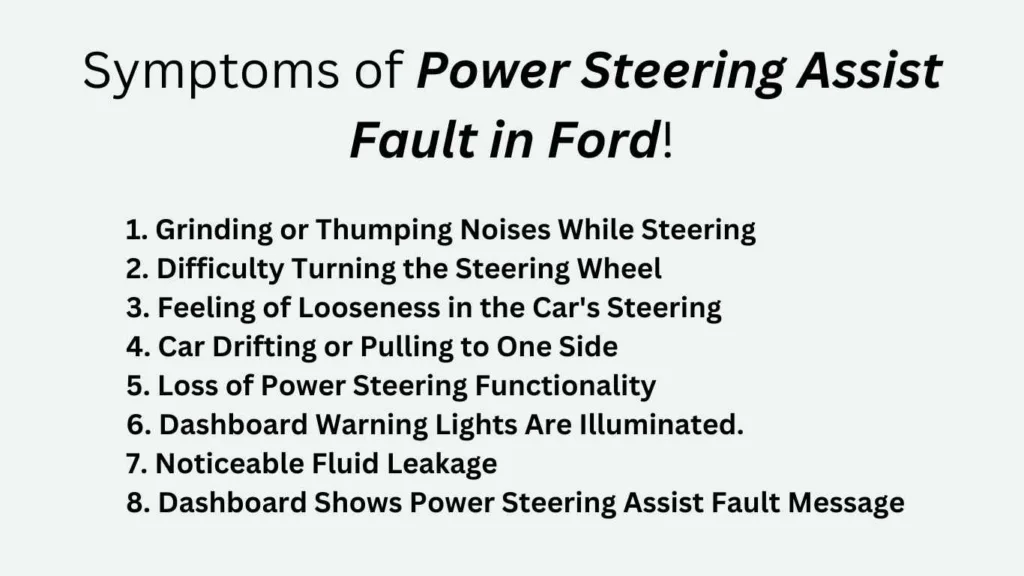
- Weird Noises: If your car makes grinding or thumping sounds when you turn the steering wheel, it indicates a power steering bug.
- Hard to Shift: If it’s difficult to move the steering wheel or it feels stiff, there might be an issue related to power steering.
- Loosen Up Steering: If the steering feels loose or not as firm as usual, it could mean an error with the power steering.
- Car Doesn’t Go Straight: When your car pulls to one side while you’re driving, even when you’re trying to steer straight, that’s a sign of trouble with power steering.
- Tough to Turn Wheel: If suddenly the power steering doesn’t work well, you’ll find it harder to move the wheel.
- Activated Warning Lights: When the CEL warning lights on the dashboard light up, it can mean the issue of steering assist fault.
- Leaking Power Steering Fluids: If you see fluid leaking from the car, especially around the wheels or under the hood, it’s a sign of a potential steering issue.
- Error Message on the Dashboard: The dashboard will show a message saying there’s a problem with the power steering if it stops working.
After knowing all the signs, it’s natural to get curious whether can you still drive with power steering assist fault or not.
You can still drive with a power steering assist fault as it will switch to manual mode. In other words, you’ll need to use your hand to drive the car instead.
Diagnostic Trouble Code Chart!
When you are planning to identify the root cause via an IDS or scan tool, it’s vital to know what the fault code indicates. To help you with that, here’s a table:
| Fault Code | Trouble Area |
| DTC B1342, B2277, B2278, C1531, C1532, C1533, and C1534 | PSCM and IC modules |
| DTC B2278, C1511, C1512, C1513, C1514, C1515, C1516, C1517, and C1581 | Torque sensor |
| DTC B1342 or B2277 | Steering column |
| DTC C1551, C1552, C1554, and C1555 | EPS fuses |
| DTC U0073 and U0121 | Power steering ECU |
| DTC C2792 a | Power steering motor |
| DTC U3000 | Steering gear |
| Others | TPS, issue with battery, PCM, or system error |
The Reasons for Power Steering Assist Fault Ford!
Due to faulty parts, system failure, or blown-out fuses, the power steering assist can stop working on Ford cars. Here are all the possible reasons why your car’s power steering doesn’t work:
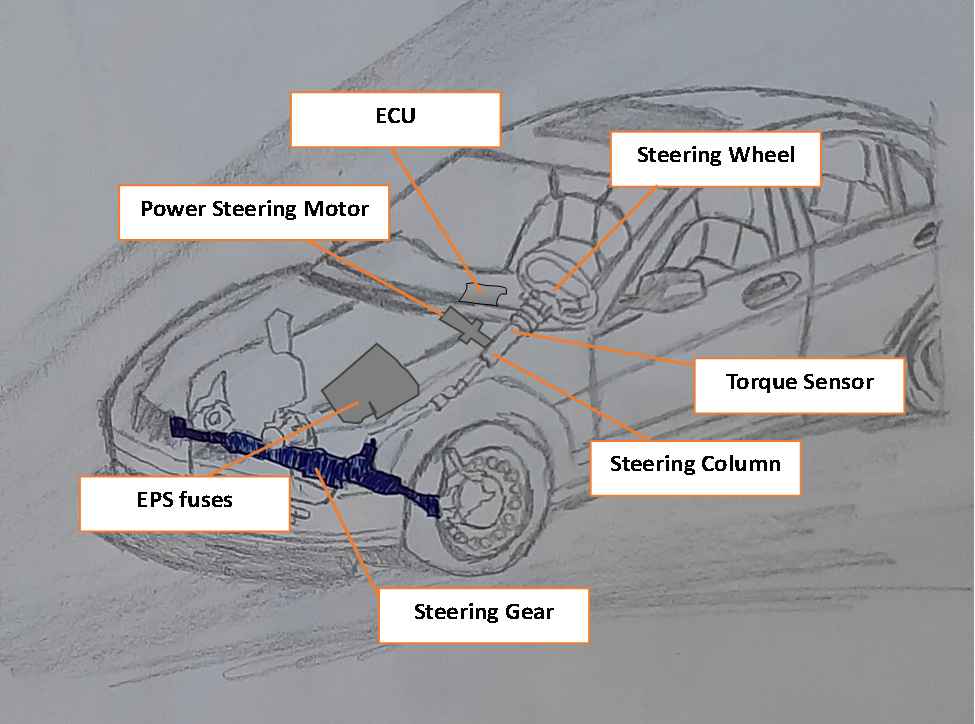
Cause #1: PSCM and IC Modules Bug
A lot of times the power steering fails to operate when the car’s inner system modules like PSCM and IC don’t work. It happens mostly when you forget to update them. To fix the issue, you’ll simply need to reset the PSCM and IC modules using an IDS or scan tool.
Cause #2: Torque Sensor Is Faulty
The power steering system consists of a few parts including a torque sensor. This measures how much you’re steering the wheel.
This sensor turns that steering effort into an electrical signal. This signal tells the car’s computer (ECU) how much power steering to give you. If this signal isn’t right, it can affect how safe it is to steer the car, especially when driving fast.
There are two types of torque sensors: ones that touch (contact) and ones that don’t (non-contact). If something’s wrong with this sensor or its signal, the power steering might not work properly. To make it work again, you’ll need to change the torque sensor.
Cause #3: Bad Steering Column
The steering column is the part that holds the steering wheel to its position. And, when this part stops working, it may trigger the car’s system causing the power steering assist mode to go disable. To get rid of this issue, you’ll need to change the steering column.
Cause #4: Dead EPS Fuses
To ensure the power steering is working fine in your car, the EPS fuses play a great role. The EPS fuses can blow out or get damaged after a few years.
When this happens, the power steering switches to manual mode (requires your hand to move the steering wheel). You can easily fix it by changing the EPS fuses.
Cause #5: Bad Power Steering ECU
The Electronic Control Unit (ECU) is like the brain of your Ford car. It helps make the engine and power steering work properly.
If this unit breaks, your power steering might stop for a bit. But if you replace the ECU, it should fix the problem.
Cause #6: Faulty Power Steering Motor
When the motor that helps your car steer easily gets too hot or stops working, it makes it hard to turn the steering wheel smoothly.
This thing causes the power steering assist mode that helps with steering won’t work anymore. To make it work again, you have to replace the part that’s causing the problem, called the power steering motor.
Cause #7: Damaged Steering Gear
The power steering assist fault can occur when the steering gear (rack and pinion) cracks or goes bad. It’s also one of the reasons why the 2011 – 2012 Ford Fusion power steering doesn’t work. To fix this issue, you’ll need to change the steering gear.
Cause #8: Other Reasons
Apart from the above reasons, there are some parts or systems that can cause the power steering assist mode to go off.
It can happen when the throttle pressure sensor (TPS) or PCM goes bad, the battery loses voltage or catches rust in the pins, or the EPS system fails.
If this is the case, change the TPS/PCM, clean the rust in the pins from the battery, change the battery, or reset the EPS system.
Note: If you turn on the fail-safe mode by mistake, it can restrict the power steering assist mode. Check this guide to know what to do when your 2010 Fusion’s power steering doesn’t work.
Fix the Ford Power Steering Assist Fault!
As resolving the power steering assist fault in the Ford car via expert can cost a lot, people go for the DIY method. Now, you can wonder and question how much does it cost to fix the power steering assist fault.
To fix the power steering assist fault, it costs around $300 – $4,500 based on the part and labor costs. This is the case if you are fixing via a Ford dealer. However, if you do it yourself, it’ll cost no more than $500 or more.
Once you know the repair or replacement cost, it’s time to learn the solutions. Let me share them below:
Solution #1: Reset PSCM and IC Modules
You can fix the power steering assist fault by resetting the PSCM and IC modules. Here’s how to reset power steering assist fault:
To reset the power steering assist fault, you’ll need to use an IDS or scan tool and go to PSCM. Then, follow the on-screen instructions to reprogram it.
After that, you’ll need to do the same process for IC modules. To know the process in detail, I suggest checking this guide about fixing the power steering assist fault Ford Escape.
Solution #2: Repair Steering Column
- To start with, make sure the car is in Neutral (N) gear and use a jack stand or hoist to lift it.
- Next, move the steering wheel to the 11 o’clock position.
- Then, take out the big battery if it’s a hybrid car. Or else, remove the 12V battery under the hood.
- After that, use the pry bar to take off the cover around the steering wheel. If you can, use a cutting tool to follow the lines and take off the panel.
- Once that’s done, take out the screws and the panel around the steering wheel.
- After that, take off the top part of the cover around the steering column.
- Now, detach the bottom part of the cover and pull out the 3 connectors on the left side of the steering wheel. Then, take off 2 clips that are nearby.
- After that, unplug the electrical connector of the Passive Anti-Theft System (PATS) transceiver. Then, pull out another clip and move the wiring to the side before taking out 2 bolts at the top of the steering wheel.
- Now, tape the wheel so it doesn’t move and detach the steering wheel along with its upper part together.
- Finally, take off the snap ring, lower jacket, sensor seal, and the steering column.
Solution #3: Change Torque Sensor
- First, take off the steering column.
- Then, use tools to remove a few parts and a seal.
- Next, disconnect electrical things and lift the front of the car.
- Check a part called the steering shaft keyway.
- Then, take out the old sensor carefully and check if it’s broken. Clean it up.
- Afterward, put in a new sensor using a special tool.
- Once it’s done, make sure the new sensor is in the right place and secure it.
- Now, put back the parts you took off.
- After that, lower the car, start the engine, and check if the steering wheel is in the middle with the new sensor.
- Finally, use a special tool to finish setting up the Steering Wheel Position Sensor.
Solution #4: Change EPS fuses
- To begin with, find the fuse box for the car fuses under the hood or under the steering wheel. You can check the owner’s manual to be sure.
- Then, remove the cover of the fuse box so you can see inside.
- After that, look for fuses that work with the EPS or PSCM system. Check if they look okay or contain burnt marks. If they’re not good, replace them with new ones. Then, put the cover back on.
- For a better understanding of the procedure, read this guide about fixing the power steering assist fault Ford Fusion.
Solution #5: Replace Power Steering ECU
- To start the process, you’ll need to take out the battery under the hood. Be sure to remove the cable after detaching the bolt with a socket.
- Then, you’ll need to take out the engine cover and disconnect the brake booster vacuum hose.
- After that, use the appropriate tool to detach the air intake pipe.
- Finally, you can take out the ECU after detaching the bolts and insert the new one. Then, reinstall all the parts.
Solution #6: Change Power Steering Motor
If your car’s power steering isn’t working right, it’s smart to get help from a car shop or a Ford store. To change the broken power steering motor, follow these steps:
- First, remove the steering column as I shared with you earlier.
- Then, disconnect the motor by removing the tie rod under the car where you can find the torque sensor.
- Once it’s done, replace it with a new one.
- Lastly, put everything back together like it was before.
Solution #7: Replace Steering Gear
- First of all, use a right-size socket to loosen all the nuts on the wheel. Then, grab the right-size wrench to loosen the jam nut. If the nuts seem stuck, gently tap them with a rubber mallet before detaching them.
- Next, use the appropriate socket to remove the tie rod nut and separate it from the knuckle with a hammer. Then, count the turns when removing the tie rod for alignment. If needed, remove the inner tie rod nut with the socket and air gun, using heat if necessary.
- Once it’s done, remove the bellows boot with needle-nose pliers and a pry bar, replace it, secure it with a wire tie, and cut off extra.
- Then, apply anti-seize on the new tie rod’s threads and install it, matching the turns from the old one.
- After that, reattach the tie rod to the knuckle, torque the castle nut, secure it with a cotter pin, and bend the pin. Then, tighten the jam nut and straighten the tie rod before putting the wheel back on.
- Finally, snugly tighten the lug nuts and torque them. In case you want to know the process in detail, I suggest checking this guide that explains how you can fix the power steering assist fault Ford Focus.
Solution #8: Other Solutions
There are a few fixes that you can try to get rid of the issue of power steering. Let me share them below so you can follow them easily:
Replace PCM Unit
- You’ll need to open the car hood and find the battery. Then, use an 8mm tool to disconnect the black (negative) cable.
- Next, turn on the headlights to use up any remaining power. Let them stay on until the power is completely drained. Wait for 30 minutes with the cable disconnected.
- Then, reconnect the black cable to the battery using the same tool. Next, turn the ignition switch to ON and wait for 10 seconds. Remember to turn off the radio.
- After that, start the engine 10 seconds after turning the ignition on. Let the engine run for 10 minutes without using the AC or wipers. Then, take a short drive to see if the issue is fixed. To know it in detail, read this guide about fixing the power steering assist fault Ford F150.
Change TPS Part
- To start with, find the air filter housing under the hood.
- Then, locate the throttle body nearby and clean it. After that, there’s a red tab you need to pull and press to disconnect a part. Check it for any damage.
- Next, disconnect the tube attached to the throttle body and remove some bolts. Be sure to take out the throttle body carefully, making sure not to damage the gasket.
- After that, check the gasket, clean it if needed, and look for any dirt where the throttle body is.
- Once it’s done, inspect the tube for dirt or oil inside. If the gasket’s good, put it back, making sure the new throttle body is facing the right way.
- Afterward, place the new throttle body in position, tighten the bolts properly, and reconnect everything you took off.
- Before starting the car, check for warning lights. Test drive to make sure everything is working well.
Clean Rust in the Pins or Change the Battery
- Firstly, open the car hood. Use a 10mm tool to loosen the nuts on the red (+) and black (-) battery connections. Then, take off the cables and put them away safely to avoid touching anything else.
- Next, take out the battery by using an 8mm tool to unscrew all the bolts. Check its voltage and then either change it or go to the next step.
- After that, use baking soda and water to clean the battery connections.
- Once clean, dry them off and put everything back where it was. Finally, close the hood.
Reprogram EPS System
To reset the EPS, you’ll need to start it by parking your car in a safe spot and then turn off the engine. After that, wait for around 10 seconds and then restart the engine. Next, the car will reset the EPS system.
Check here if you want to know it in detail where I’ve shared how you can fix the power steering assist fault Ford Explorer.
Overall Thoughts
That’s all you should about the power steering assist fault in a Ford car! I hope this guide helps you to know more about this and ensure to try the troubleshooting techniques at home. Good Luck!
I hope after this guide, tackling the power steering assist fault in your Ford is totally doable! Through this ultimate guide, I wanted to make sure that you’ve got the tools to diagnose, understand, and fix the issue.
Often, you don’t need to be a car expert to make things right. It simply takes knowing some basic ideas on resetting modules, changing fuses, and replacing components. Take it one step at a time. You’ve got this!
Also, I am working hard to come up with a more inclusive series like this Ford power steering assist one. Until now I’ve covered separate articles on this issue, and you can expect more to be added in the future. Don’t forget to check the entire series.

